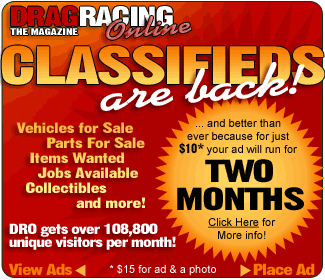
Miller was more blunt: "In drag racing, the
name of the game's nitromethane. People come
to the track to see cars go more than 300 miles
an hour in a quarter-mile."
Roll-cage protection received little resistance.
Coil explained why: "After you become fully
aware that sort of thing can happen and as simple
as it is to put a shield behind the driver's
noggin, gee, why not? It seems like there's
no downside to that."
Coil said the roll cage shields that are affixed
to Force's, Eric Medlen's, and Densham's Ford
Mustangs weigh eight pounds each. Coincidentally,
each of the new-compound tires is eight pounds
lighter than the one it replaced. So that's
an eight-pound swing in the driver's favor.
"No big deal," Coil said.
Some drivers and observers say unless and until
NHRA figures a way to take some of the downforce
load from the rear wing of a Top Fuel dragster,
crashes will continue to happen at these speeds.
Teams could discuss the merits of modifying
the monostrut rear end Don Garlits has extolled
for years and Mike Kloeber has studied. They
could calculate how to redesign and reinforce
a dragster chassis if the rear wing were trimmed.
They could advocate canards or side pods.
But none of that might matter. It depends if
the task force decides downforce is the enemy.
Or if it needs to decide anything profound at
all. It's premature to expect any decisions,
with only its second meeting set for noon July
30 at Sonoma, Calif. It was hard enough just
to confirm the names of the task-force members.
Don Taylor, NHRA's senior director
ADVERTISEMENT
 |
of
national technical operations, repeatedly declined
to name the sanctioning-body officials and Top
Fuel and Funny Car team owners and crew chiefs
he is working with. However, DRO learned that
the list includes Kenny Bernstein, Jerry Gwynn,
Alan Johnson, Connie Kalitta, Dick LaHaie, Jim
Oberhofer, Don Prudhomme, Tim Richards, Tim
Wilkerson, and Chuck Worsham.
But Taylor's paranoia twisted one ho-hum question
into a series of uncertainties. Why were drivers
not informed about who was on the committee?
Or that it had a two-hour meeting in Denver
that Taylor at first denied? What's on the agenda?
Does the task force have a shelf life? When
will it share its progress with the racers or
public? Is it required to recommend any changes
at all? Why isn't a Goodyear engineer or representative
on the task force? And why is Wilkerson, also
a team owner, the lone driver?
Jerry Archambeault, vice-president of public
relations and communications, said, "We don't
have anything to hide, but we don't have anything
to announce." Maybe NHRA doesn't have anything
to hide at all. But it did have news to announce.
Many drivers said in Seattle they had no idea
the task force is staffed already, how the members
were selected, or how to contribute to the discussions.
The consensus was "We don't want to blame NHRA.
We just would like to be informed and know that
somebody is doing something."
At least Coil and Miller helped address some
of those questions. Miller said drivers weren't
selected to serve on the task force because
"it's not a driver-input situation. If you invite
them, you might as well invite an oncologist.
It's for the nuts-and-bolts guys; itís for the
gear heads." He said the committee needs to
be streamlined to be productive and that driver
participation "slows the process down."
Miller's candor is appreciated. However, he
and his colleagues might do well to remember
that their rear ends aren't the ones strapped
into the race cars.
Perhaps it's because Russell's death resulted
from a freakish, nearly- impossible-to-duplicate
occurrence. Perhaps it's because all racers
are uniquely geared. But they accept the risks
inherent to their sport and don't spend much
time dwelling on danger. So it would seem unnatural
to many of them to analyze the ways to reduce
the risk. That would get dangerously close to
erasing the thrill.

|